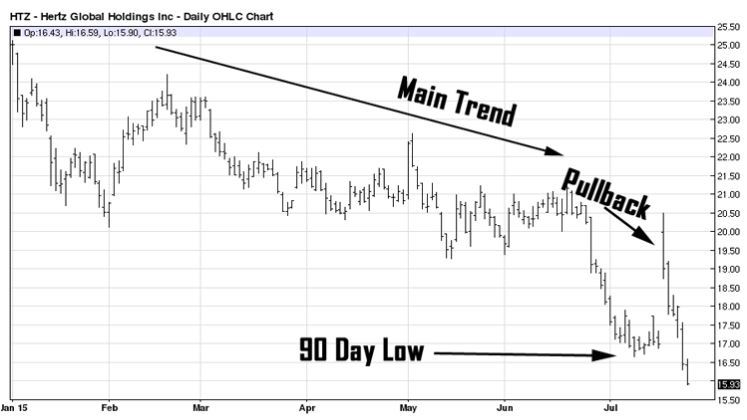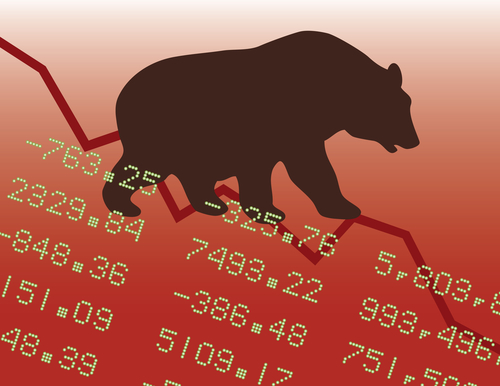When you purchase a put option, you plan to profit when the underlying asset declines in price. The more the price declines, the more value the put option gains. During prolonged bear market cycles, when markets continuously decline over time, buying put options is one of the best strategies. And if you trade stocks and believe that earnings are going to cause one of your current positions to decline in price, buying a put option can protect or mitigate the downside selling pressure that the stock is going through; if for example earnings are below expectations during a particular earnings quarter.

Similarly to call options, you don’t have to own the underling asset to benefit from a put option. So instead of shorting or selling short assets that you don’t own, you can purchase a put option; this can result in less financial risk to your account than selling the actual underlying asset instead. When you buy a put option, you know in advance how much you can lose, but when you short the underlying asset instead, you don’t know your actual risk unless you use buy stop orders (stop loss orders for short traders), and even then an overnight gap or sudden news can cause the asset to gap above the buy stop price, increasing your intended risk on the trade by an unforeseeable amount.
An All-In-One Guide for Every Futures Trader
From basic futures trading background to complex strategies using options, Bollinger bands, Fibonacci sequences, and much more, this guide has something for every type of futures trader. Learn the basics or enhance your futures trading strategy with RJO Futures!
Download Your Complimentary Technical Analysis Guide TODAY!
One very popular method of using puts is to initiate a long put position as a hedge or a protection against strong downside market moves that can impact your existing positions. If you own a stock portfolio, you can purchase puts instead of liquidating or protecting your portfolio using stop loss orders. While the mitigation may not result in 100% protection, it can help you avoid liquidating the actual asset, protect your portfolio as a whole or help you protect only part of the portfolio by purchasing puts to protect only those assets that are at risk at any given time.
The best type of market environment for a put buyer, is one that’s about to decrease in value, so in essence, you have to start thinking like a short seller to benefit from long put options. There are several technical indicators that I use consistently, to trade to the short side or to help me profit from bearish market environment.
One of the best indicators is scanning for assets that are making 90 day price lows. According to extensive back tests, assets that trade at the 90 day price low, tend to continue moving lower over time. I suggest you create a weekly list of assets that meet this criteria and combine it with a short term technical indicator that you can utilize to fade against the main downtrend.
In the example above you can see the stock trading gradually lower. You always want to trade in the direction of the main trend, so the first step is to make sure that the asset is moving lower over time. The biggest mistake you can make is to trade against the main trend, avoiding this one mistake can make a big difference in your trading.
Once you identify the main trend, you wait for the asset to reach a 90 day price low or break below the 90 day price low. The next step is to wait for a pullback against the main trend AND the 90 day price low. You can use one of several short term technical indicators or a set up based on a price pattern, to help you identify the pullback against the main trend, and alert you to the best time to buy a put option, before the assets reverts back to the main trend; which is the most likely outcome from a statistical perspective and from my experience over the past two decades of trading both sides of the market equally.

There are three different types of put options: at the money, in the money and out of the money, and each one has a distinct advantage and disadvantage and that’s another factor we have to take into account before initiating a long put option. A put option is at the money if the strike price of the option and the price of the underlying asset are on at the same price level. For example, if XYZ stock is priced at $50.00 per share and you buy a put option with a strike price of $50.00, the option would be at the money.
If on the other hand, the strike price was at $60.00 and the price of the underlying asset was at $50.00, the put option would be in the money. And if the strike price was $40.00 and the underlying asset was at $50.00, the put option would be out of the money.
The most expensive put option is one that’s in the money, because in addition to time value, the option also holds intrinsic value, which in addition to time value, is the second biggest factor that determines the price of the option; with volatility being the first.
As the strike price moves from being in the money to being at the money, the price of the option decreases, because the option does not have intrinsic value, but because the option is on the verge of being in the money, the price of the option is lower than the in the money option.
The lowest price put option is the out of the money put option, where the strike price of the option is below the price of the underlying asset. This type of put option holds no intrinsic value and has the least chance of ending up in the money at expiration.
You have to keep in mind that the market price of an option at any given time is entirely based on the odds of that option expiring in the money. Therefore, the closer the put option gets to being in the money, the more it will be worth and the further the put option gets from being in the money, the less it will be worth.
How close or far away you choose to buy a put option is largely determined by the type of price move you are expecting from the underlying asset. If you are expecting a small to moderate price move, an in the money option would offer you the best choice since the underlying asset needs to move moderately lower for the price of the put option that’s in the money to increase.
If on the other hand you are expecting the price of the asset to decrease sharply over a short period of time, then an out of the money put option may be the best choice, since the option will offer you the most leverage under the circumstances.
Keep in mind, that from a perspective of probabilities, the odds favor options that are in the money over out of the money, since put options that are in the money have a much higher chance of ending up profitable prior to expiration.
When deciding which put option to purchase, always take into account the worst case scenario as well as the potential upside. Choosing the best put option can be tricky, but with time and more importantly actual trading experience, you will develop a natural feel for different options and how they react to the underlying asset.
